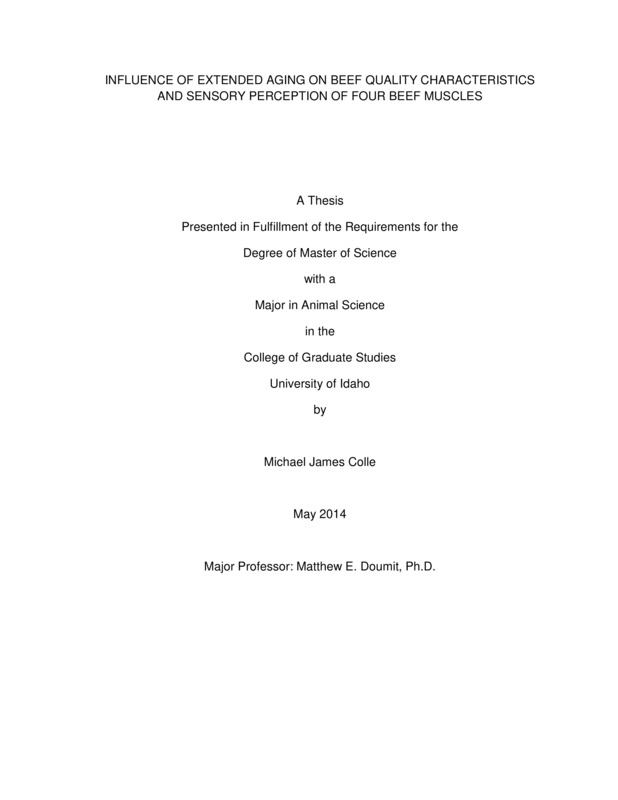INFLUENCE OF EXTENDED AGING ON BEEF QUALITY CHARACTERISTICS AND SENSORY PERCEPTION OF FOUR BEEF MUSCLES
Colle, Michael. (2014). INFLUENCE OF EXTENDED AGING ON BEEF QUALITY CHARACTERISTICS AND SENSORY PERCEPTION OF FOUR BEEF MUSCLES. Theses and Dissertations Collection, University of Idaho Library Digital Collections. https://www.lib.uidaho.edu/digital/etd/items/colle_idaho_0089m_10274.html
- Title:
- INFLUENCE OF EXTENDED AGING ON BEEF QUALITY CHARACTERISTICS AND SENSORY PERCEPTION OF FOUR BEEF MUSCLES
- Author:
- Colle, Michael
- Date:
- 2014
- Program:
- Animal and Veterinary Science
- Subject Category:
- Animal sciences
- Abstract:
-
The objective was to determine the influence of post-fabrication aging (2, 14, 21, 42, and 63 days) on beef quality characteristics and consumer sensory perception of top loin, top round, top sirloin, and bottom round steaks. The
longissimus lumborum (LL),semimembranosus (SM),gluteus medius (GM), andbiceps femoris (BF) were removed from their respective wholesale cuts, divided into 5 sections, and assigned to aging treatments. At the end of each aging period, two 2.54 cm-thick steaks were cut from designated sections for specific analyses and displayed in a glass-front retail display case at 3°C for up to 4 days. Thiobarbituric acid reactive substances to measure lipid oxidation were analyzed on days 0, 1, and 4 of retail display. Aerobic plate counts were taken on day 0 and 4 of retail display. Two color measurements (L*, a*, and b*) per steak were taken each day of retail display with a colorimeter. Oxygenated lean color, amount of browning, discoloration, surface discoloration, and color uniformity were also measured daily by two evaluators. Following retail display, Warner-Bratzler shear force was performed. Four consumer panels (n=60 per muscle) evaluated cooked steaks from each aging time for overall acceptability, tenderness, juiciness, and flavor. Data were analyzed using the Mixed Model procedure of the Statistical Analysis System and significance was determined at P < 0.05. Lipid oxidation increased (P < 0.05) with longer aging period and retail display time. Aerobic plate counts increased (P < 0.05) with longer aging periods of all muscles. Furthermore, an aging period by day of retail display interaction (P < 0.05) was observed for a* and b* values for all muscles and L* values for the LL. An aging period by day of retail display interaction (P < 0.05) was observed for oxygenated lean color in the BF, GM, and LL; for amount of browning and discoloration in the BF, LD, and SM; for surface discoloration in the BF and LL; and for color uniformity in the BF, GM, and LL. Longer aging periods resulted in steaks that became darker, more discolored, and less uniform during retail display. Warner-Bratzler shear force values decreased (P < 0.05) with longer aging for the LD and SM, while there was no difference observed for the BF and GM. Sensory panel results demonstrated longer aging periods increased (P < 0.05) acceptability of the SM, tenderness of all muscles, and tended to increase (P = 0.07) the juiciness of the SM. Extended aging reduced retail shelf-life yet increased consumer perception of tenderness of all muscles and juiciness and overall acceptability of the top round. - Description:
- masters, M.S., Animal and Veterinary Science -- University of Idaho - College of Graduate Studies, 2014
- Major Professor:
- Doumit, Matthew E
- Committee:
- Richard, Ron P; Killinger, Karen M; Bohlscheid, Jeffri C
- Defense Date:
- 2014
- Identifier:
- Colle_idaho_0089M_10274
- Type:
- Text
- Format Original:
- Format:
- application/pdf
- Rights:
- In Copyright - Educational Use Permitted. For more information, please contact University of Idaho Library Special Collections and Archives Department at libspec@uidaho.edu.
- Standardized Rights:
- http://rightsstatements.org/vocab/InC-EDU/1.0/

